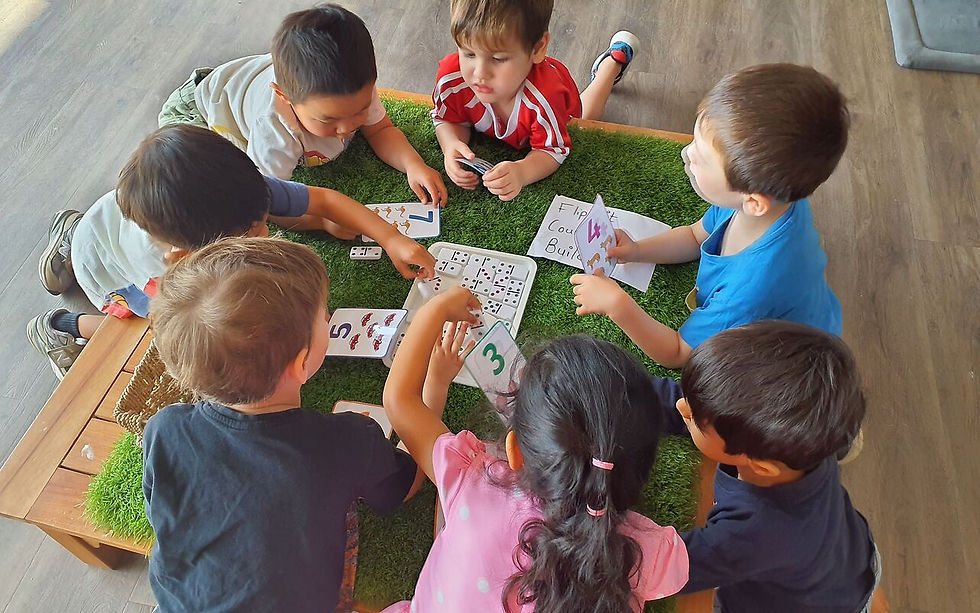The Magic of Tuff Trays in Early Learning
- Discover My World

- Jul 29
- 3 min read
If you’ve spent any time in an early learning environment, or perhaps scrolled through a few Pinterest boards - you’ve probably seen a Tuff Tray in action. These large, shallow trays might not look like much at first glance, but give a child five minutes with one and you’ll quickly see the magic unfold. At DMW, we’re big fans of tuff trays and how they support open-ended, engaging learning experiences that spark curiosity and creativity in little minds.

What is a Tuff Tray?
A tuff tray is a durable, low-sided tray originally designed for builders to mix materials like cement or paint. But over time, early childhood educators got wise to their potential and began using them to support sensory and small world play.
They’re large enough for a few children to gather around, and shallow enough that little hands can easily reach and explore the materials inside. Whether they’re filled with water, leaves, construction vehicles, spaghetti or fairy dust, tuff trays are the ultimate canvas for play.
Why Are Tuff Trays Beneficial?
Tuff trays support:
Sensory exploration: Children can feel, squish, pour, scoop, and manipulate a variety of textures and materials.
Language development: Rich vocabulary emerges during tuff tray play—“sticky,” “slippery,” “crunchy,” “float,” and “sink” are just the beginning.
Social interaction: With multiple children playing at once, tuff trays become little hubs of collaboration, problem-solving, negotiation, and teamwork.
Fine motor skills: Pinching, picking up, transferring, and sorting materials helps develop strength and coordination.
Imaginative and dramatic play: Tuff trays provide the perfect space for small-world play scenarios that mirror children’s interests and experiences.
Invitations to Play – What Does That Mean?
In early childhood education, an “invitation to play” is a thoughtfully arranged set-up designed to provoke curiosity, exploration and interaction. It’s a way of saying, “Come and explore this with me” without a set of rules or outcomes. Tuff trays are ideal for this. Whether it’s an under-the-sea adventure complete with blue rice and sea creatures, or a dinosaur excavation with buried bones, tuff trays offer children the chance to enter play on their own terms—led by their imaginations, not adult instructions.
Tuff Trays and the EYLF
Tuff trays align beautifully with the Early Years Learning Framework (EYLF), particularly:
Outcome 1: Children have a strong sense of identity – through collaborative play and expression of ideas.
Outcome 2: Children are connected with and contribute to their world – especially when trays are inspired by nature, community events or cultures.
Outcome 4: Children are confident and involved learners – engaging with curiosity, creativity, and problem-solving.
Outcome 5: Children are effective communicators – developing language, storytelling and symbolic thinking during imaginative play.
Educators at DMW use tuff trays to follow the lead of the children’s interests—whether it’s sparked by a snail found in the garden, a conversation about camping, or a fascination with diggers. Other times, we plan more intentional learning experiences, using tuff trays to highlight a theme or celebration, like Insect Week, Harmony Day, or Science Week.
Where Can I Buy a Tuff Tray?
Tuff trays are surprisingly easy to source! In Australia, you can find them at:
There are even versions with stands so the tray can be raised off the ground for different height levels although these are a little expensive and small tables do the job just fine!
Tuff Tray Ideas to Try
Looking for inspiration? Here are just a few of our favourites:
Arctic Small World – Shaving foam “snow”, blue gel water, penguins and polar bears.
Construction Zone – Kinetic sand, diggers, rocks, and pipes.
Nature Sorting – Leaves, sticks, bark, and flowers for categorising or creating patterns.
Potion Making Station – Herbs, coloured water, pipettes and bowls for some messy science fun.
Book-Inspired Play – Create scenes from favourites like The Very Hungry Caterpillar or We're Going on a Bear Hunt.
Tuff Trays at Home
Tuff trays aren’t just for the classroom—they’re fantastic at home too! You don’t need to overthink it. A handful of materials from the kitchen, backyard, or toy shelf can go a long way. Try filling it with soapy water and sponges for a “car wash”, some cereal for sensory play with scoops and cups, or even mud and dinosaurs for outdoor messy play.
One of the best parts? Containment. All the mess stays (mostly) in one place.
Our Final Thoughts
Tuff trays may seem simple, but they open up a world of possibility for children’s learning and play. Whether organically inspired by a child's interest, or carefully crafted by an educator with a learning intention in mind, they create powerful opportunities for discovery, connection, and growth.
At Discover My World, tuff trays are just one of the many ways we embrace child-led exploration while weaving in purposeful learning. They remind us that big learning often happens in small, playful spaces.











Comments